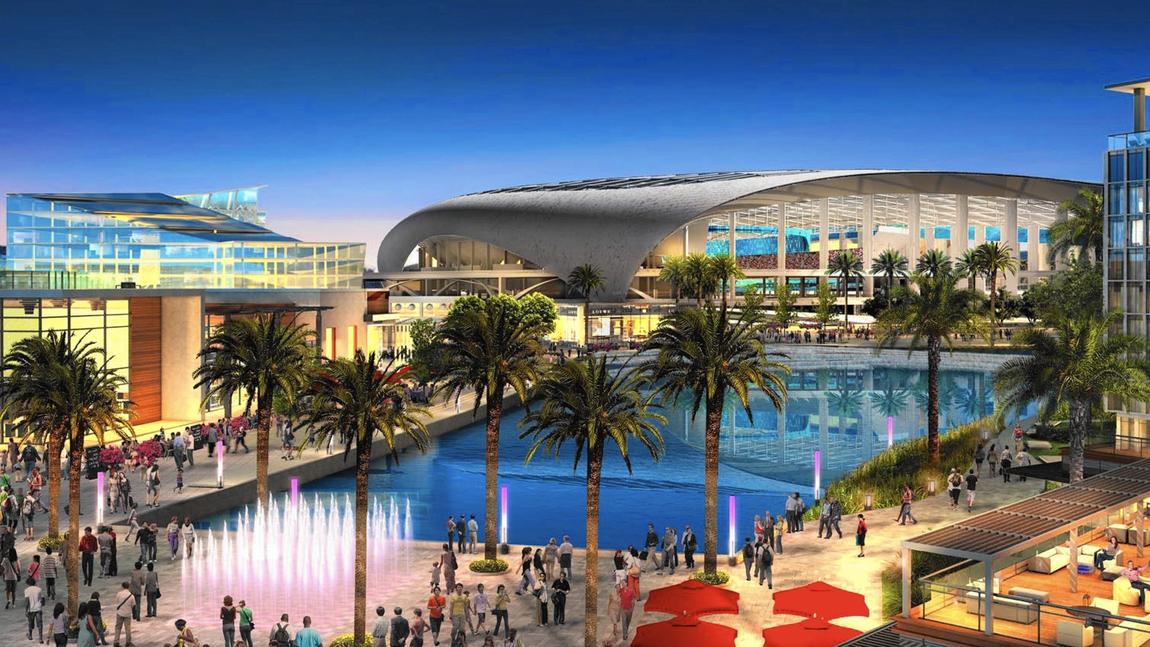An investment group controlled by the owner of the St. Louis Rams NFL team has joined forces with Stockbridge Capital Group, which owns the 298-acre Hollywood Park site in Inglewood, Calif., to add an 80,000-seat football stadium and 6,000-seat performance arena to a massive mixed-use development Stockbridge already has in the works, according to the Los Angeles Times and other news reports.
A year ago, Kroenke Group purchased 60 acres of land adjacent to the Forum arena in Inglewood. With its deal with Stockbridge, Kroenke Group’s owner, billionaire real estate developer Stan Kroenke, becomes the first existing NFL owner to control enough land in the Los Angeles market to accommodate a football stadium and parking since the Rams left L.A. for St. Louis after the 1994 season.
For decades, team owners in other cities have used the threat of relocating to Los Angeles as leverage for negotiating improvements to their own stadiums from local municipalities or states. And Kroenke has expressed displeasure with the conditions of Edward Jones Dome in St. Louis, where the Rams currently play.
The Times reports that next month the Rams can opt out of its 30-year lease in St. Louis 10 years early and convert it to a year-to-year arrangement. But the earliest the Rams could relocate to Los Angeles would be 2016.
No tax dollars would be used to build the Hollywood Park development, including the stadium. The investors are already gathering signatures to put the project onto the city’s municipal ballot this year. Inglewood’s Mayor James Butts, Jr. is on record supporting this project, which the investors have dubbed the City of Champions Revitalization Project.
The developer Wilson Meany, with offices in L.A. and San Francisco, is heading up this development, which, if approved, could be completed by 2018. HKS Architects is also involved in this project.
Kroenke and Stockbridge’s proposal is competing with at least two other plans for new stadiums in or around L.A. The entertainment giant AEG, which owns this city’s professional hockey and soccer teams, wants to build a $1.5 billion football stadium in downtown L.A., called Farmers Field, along with a new wing for the city’s nearby convention center. Another real estate magnate, Ed Roski, has had a stadium plan for City of Industry, Calif., on the table for several years. However, neither of these competing plans has mustered a commitment from an NFL team to relocate.
The Hollywood Park project would include more than 4 million sf of retail, office, and residential space, and 25 acres of parks. But to move forward, the Rams would have to commit to moving, and the project would need to get past any political or environmental opposition.
Related Stories
| Jun 12, 2014
Zaha Hadid's 'gravity defying' Issam Fares Institute opens in Beirut
The design builds upon the institute’s mission as a catalyst and connector between AUB, researchers and the global community.
| Jun 12, 2014
Tod Williams Billie Tsien Architects' design selected for new UCSC facility
The planned site is a natural landscape among redwood trees with views over Monterey Bay, a site that the architects have called “one of the most beautiful they have ever worked on.”
| Jun 12, 2014
Austrian university develops 'inflatable' concrete dome method
Constructing a concrete dome is a costly process, but this may change soon. A team from the Vienna University of Technology has developed a method that allows concrete domes to form with the use of air and steel cables instead of expensive, timber supporting structures.
| Jun 11, 2014
David Adjaye’s housing project in Sugar Hill nears completion
A new development in New York's historic Sugar Hill district nears completion, designed to be an icon for the neighborhood's rich history.
| Jun 11, 2014
Bill signing signals approval to revitalize New Orleans’ convention center corridor
A plan to revitalize New Orleans' Convention Center moves forward after Louisiana governor signs bill.
| Jun 11, 2014
5 ways Herman Miller's new office concept rethinks the traditional workplace
Today's technologies allow us to work anywhere. So why come to an office at all? Herman Miller has an answer.
| Jun 11, 2014
Koolhaas’ OMA teams with chemical company to study link between color and economy
Dutch company AkzoNobel is partnering with Rem Koolhaas' firm OMA to study how the application of colorful paints and coatings can affect a city's economic development.
| Jun 11, 2014
Oceanic oases: Two new luxury condominiums under construction in South Beach
Slated for completion in 2015, both the seven-story, 275,141 square-foot One Ocean and six-story, 190,654 square-foot Marea will offer landscapes by Enzo Enea and interiors by Yabu Pushelberg.
| Jun 11, 2014
Esri’s interactive guide to 2014 World Cup Stadiums
California-based Esri, a supplier of GIS software, created a nifty interactive map that gives viewers a satellite perspective of Brazil’s many new stadiums.
| Jun 10, 2014
Site optimization: Paving the way for smoother land development projects
The biggest cost differential when dealing in site development from one site to another is the earthwork. So, when selecting a site, it is critical to not only take into account the initial purchase price of the property, but also what sort of investment it will take to prep the site for development.

















